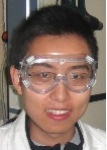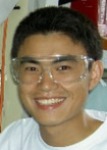Org. Synth. 2014, 91, 106-115
DOI: 10.15227/orgsyn.091.0106
Synthesis of Arylboronic Pinacol Esters from Corresponding Arylamines
Submitted by Di Qiu, He Meng, Liang Jin, Shengbo Tang, Shuai Wang, Fangyang Mo, Yan Zhang and Jianbo Wang
*1
Checked by Austin Smith and Margaret Faul
1. Procedure
A. 4,4,5,5-Tetramethyl-2-(4-nitrophenyl)-1,3,2-dioxaborolane (2). A 3-necked 250-mL round-bottomed flask equipped with a 2.5 cm rod-shaped, Teflon coated magnetic stir bar and fitted with a reflux condenser, glass addition funnel, and thermocouple is charged with 4-nitroaniline 1 (5.52 g, 39.6 mmol, 1.0 equiv), diboronpinacol ester (B2pin2, 10.66 g, 41.5 mmol, 1.05 equiv), and benzoyl peroxide (193 mg, 0.77 mmol, 0.02 equiv) under ambient atmosphere (Notes 1 and 2). The mixture is dissolved in MeCN (60 mL), and the resulting solution is stirred (700 rpm) at 22 °C with the temperature maintained by a water bath. tert-Butyl nitrite (tBuONO, 6.17 g, 53.8 mmol, 1.36 equiv) diluted by MeCN (40 mL) is then added via an addition funnel over a 1 h time period (Notes 3 and 4). The solution is allowed to stir at 23 °C for an additional 4 h, with the temperature maintained by a water bath (Note 5). Upon complete consumption of 1 as indicated by TLC analysis, the resulting solution is concentrated with a rotary evaporator to remove MeCN (40 °C, 40 mmHg) (Note 6). The crude residue is filtered over a flash silica gel plug (60 g) eluting with petroleum ether-ethyl acetate (20:1, 750 mL) until TLC analysis shows that no product 2 is still eluting from the silica gel (Note 7). The filtrate is then concentrated with a rotary evaporator (25 °C, 40 mmHg), and the residue is further purified by silica gel column chromatography, eluting with approximately 500 mL petroleum ether until product emerges as indicated by TLC, and then eluting with approximately 1000 mL of petroleum ether-ethyl acetate (100:1)(Note 8). The combined eluents are concentrated with a rotary evaporator (25 °C, 40 mmHg) and further evaporated with an oil vacuum pump for 30 min at room temperature to afford the product 2 (7.10–7.32 g, 72–74%) as a pale yellow solid (Note 9), which was >97% pure as determined by GC analysis (Note 10).
2. Notes
1.
4-Nitroaniline (99%) was purchased from Aldrich Chemical Company, Inc. and used as received. The submitters used
4-nitroaniline that was supplied by Sinopharm.
2.
Diboronpinacol ester (
B2pin2, 99%) and
benzoyl peroxide (
BPO, 97%) were purchased from Aldrich Chemical Company, Inc. and used as received. The submitters used
diboronpinacol ester (
B2pin2) from Ouhe Corporation in Beijing, China.
3.
MeCN (>99%) was purchased from Aldrich Chemical Company and used as received. The submitters used
MeCN (AR) from Beijing Chemical Corporation. There action is not sensitive to the presence of water.
tert-Butyl nitrite (
tBuONO, 90%) was purchased from Aldrich Chemical Company, Inc. and used as received.
4. The temperature of the solution rose from 22 °C to 23.5 °C during the 1h addition of
tBuONO. No gas evolution or solvent reflux was observed.
5. A water bath was used throughout the course of the 4 h reaction, with the temperature stabilizing at 23 °C. No gas evolution or solvent reflux was observed.
6. TLC analysis was performed with silica gel plates (2.5 cm x 7.5 cm, glass backed, purchased from EMD Chemicals in Darmstadt, Germany), using petroleum ether-ethyl acetate (3:2) as eluent. The aniline
1 is yellow by visible light and dark gray under 254 nm UV lamp. R
f= 0.31 (petroleum ether-ethyl acetate, 3:2).
7. For silica gel column chromatography, 230-400 mesh, 0.040-0.063 mm particle size silica gel (EMD Chemicals, Darmstadt, Germany) was employed. TLC analysis was performed with silica gel plates (2.5 cm x 7.5 cm, glass backed, purchased from EMD Chemicals in Darmstadt, Germany), using petroleum ether-ethyl acetate (20:1) as eluent. The product
2 is purple under 254 nm UV lamp. R
f= 0.23 (petroleum ether-ethyl acetate, 20:1).
8. The crude residue was dissolved in 20:1 petroleum ether-ethyl acetate (15 mL), and the solution was charged onto a column (diameter = 5 cm) of silica gel (220 g). The column was eluted with approximately 500 mL petroleum ether. When TLC analysis showed that product
2 appeared from the column, the eluent was changed to petroleum ether-ethyl acetate (100:1, approximately 1000 mL). Fractions 16-35 were indicated by TLC to contain
2 and thus combined and evaporated (25 °C, 40 mmHg).
9. Characterization data of
2: 4,4,5,5-Tetramethyl-2-(4-nitrophenyl)-1,3,2-dioxaborolane (
2). Pale yellow solid; R
f= 0.23(petroleum ether-ethyl acetate, 20:1); mp = 108.5–109.5 °C;
. 1H NMR
pdf(400 MHz, CDCl
3) δ: 1.37 (s, 12H), 7.96 (d,
J = 8.0 Hz, 2H), 8.18 (d,
J = 8.0 Hz, 2 H);
13C NMR
pdf(100 MHz, CDCl
3) δ: 24.8, 84.6, 122.3, 135.6, 149.8, IR (thin film): 2961, 1600, 1519, 1365, 1343, 1141, 1086, 857, 701 cm
-1. EI-MS (
m/z, relative intensity): 249 (M
+, 18), 234 (100), 163 (51), 150 (23), 149 (6), 104 (9), 85 (7), 59 (7), 43 (11), 42 (7). HRMS (ESI) calcd for C
12H
17BNO
4 [M+H]
+ 250.1251; found 250.1245. Anal. calcd for C
12H
16BNO
4: C, 57.87; H, 6.47; N, 5.62. Found: C, 58.12; H, 6.88; N, 5.41.
10. GC conditions: Agilent 6890N; column 19091J-413 (30 m x 0.32 mm), HP-5; temperature profile: initial temp = 61 °C, final temp = 280 °C, temperature gradient = 20 °C /min. Retention time of
2: 11.29 min.
Handling and Disposal of Hazardous Chemicals
The procedures in this article are intended for use only by persons with prior training in experimental organic chemistry. All hazardous materials should be handled using the standard procedures for work with chemicals described in references such as "Prudent Practices in the Laboratory" (The National Academies Press, Washington, D.C., 2011 www.nap.edu). All chemical waste should be disposed of in accordance with local regulations. For general guidelines for the management of chemical waste, see Chapter 8 of Prudent Practices.
These procedures must be conducted at one's own risk. Organic Syntheses, Inc., its Editors, and its Board of Directors do not warrant or guarantee the safety of individuals using these procedures and hereby disclaim any liability for any injuries or damages claimed to have resulted from or related in any way to the procedures herein.
3. Discussion
The pinacol arylboronates can be accessed by Pd-catalyzed borylation of arylhalides (Miyaura borylation), or by Ir- or Rh-catalyzed direct borylation via aromatic C-H bond activation. These borylation methods have been widely applied in organic synthesis. The direct conversion of aromatic amine to arylboronates represents an entirely different method. It is metal-free, using cheap and abundant arylamines as starting materials. The reaction is carried out under mild conditions and tolerates various functional groups.
The procedure described here is based on our initial communication.
2 We have noted that the substituents on the aromatic ring of arylamine substrates significantly affect the yields of borylation products. Recently, we have reported modified reaction conditions, under which the borylation is carried out in
MeCN at 80 °C without the use of
BPO.
3 In most cases, the modified reaction conditions give slightly improved yields. For
p-nitroaniline 1 and
p-toluidine
5, the borylation has also been carried out under modified reaction conditions (
MeCN, 80 °C, without
BPO). The borylation products were obtained in 59% and 58% yields, respectively. In Figure 1 and Figure 2, the substrate scope of the metal-free borylation has been summarized.
Appendix
Chemical Abstracts Nomenclature
(Registry Number)
4,4,4',4',5,5,5',5'-Octamethyl-2,2'-bi(1,3,2-dioxaborolane): diboronpinacol ester; (73183-34-3)
tert-Butyl nitrite; (540-80-7)
Benzoyl peroxide; (94-36-0)
4-Nitroaniline; (1) (100-01-6)
4,4,5,5-Tetramethyl-2-(4-nitrophenyl)-1,3,2-dioxaborolane; (2) (171364-83-3)

|
Di Qiu was born in Tianjin of China. He received his B.S. degree from Peking University in 2010. He is now a graduate student in Prof. Jianbo Wang’s laboratory. His current research projects are focused on gold-catalyzed C-H bond functionalization and the transformations based on aryldiazonium salts.
|

|
He Meng was born in September 1991 in Shijiazhuang of Hebei province. He is expecting B.S.degree in chemistry of Peking University. Now he is a senior student in Prof. Jianbo Wang’s group.
|

|
Liang Jin was born in April 1991 in Shanghai of China. He has received his B.S. degree (in Prof. Jianbo Wang’s group) from Peking University in 2013. Now he is a graduate student in Prof. Huwei Liu’s group in chemistry department of Peking University.
|

|
Shengbo Tang was born in September 1992 in Jilin province of China. He is expecting B.S. degree in chemistry of Peking University. Now he is a junior student in Prof. Jianbo Wang’s group. His hobbies are playing basketball and playing guitar.
|

|
Shuai Wang was born in April 1993 in Tianjin of China. He is expecting B.S. degree in chemistry of Peking University. Now he is a junior student in Prof. Jianbo Wang’s group. His favorite hobby is fitness.
|

|
Fanyang Mo was born in Liaoning Province of China. He received his B.Sc. and M.Sc. degrees from Beijing Institute of Technology (P. R. of China) in 2004 and 2006 under the supervision of Professor Zhiming Zhou. He then obtained his Ph.D. from Peking University, under the supervision of Prof. Jianbo Wang in 2010. He is currently a postdoctoral fellow in Prof. Guangbin Dong’s group at University of Texas at Austin.
|

|
Yan Zhang was born in Shandong province of China. She received her B.S. and Ph. D. degrees from Lanzhou University. She continued her research as a postdoctoral fellow in Hong Kong University of Science and Technology (2002 -2004), University of Innsbruck & Leibniz Institute of Surface Modification (IOM) e. V. (2004-2005), University of Missouri-St. Louis (2005-2006), and Auburn University (2006-2008). She has joined Peking University since 2008 as an associate professor. Her research focuses on the application of transition metal complexes of N-heterocyclic carbenes and synthesis of small biological compounds.
|

|
Jianbo Wang was born in Zhejiang province of China. He received his B.S. degree from Nanjing University of Science and Technology in 1983, and his Ph.D. from Hokkaido University in 1990. He was a postdoctoral associate at the University of Geneva from 1990 to 1993, and University of Wisconsin-Madison from 1993 to 1995. He began his independent academic career at Peking University in 1995. His research interests include the catalytic metal carbene transformations.
|

|
Austin G. Smith was born in Hartford, CT in 1984. He graduated in 2006 with a B.A. in chemistry from the College of the Holy Cross in Worcester, MA. He obtained his Ph.D from the University of North Carolina at Chapel Hill in 2011, where he studied stereoselective ring-opening reactions with donor-acceptor cyclopropanes under the direction of Professor Jeffrey Johnson. From 2011-2012 he was a postdoctoral research associate under the direction of Professor Huw M. L. Davies at Emory University. Austin joined the Chemical Process Research & Development group at Amgen in Thousand Oaks, CA in 2012.
|
Copyright © 1921-, Organic Syntheses, Inc. All Rights Reserved